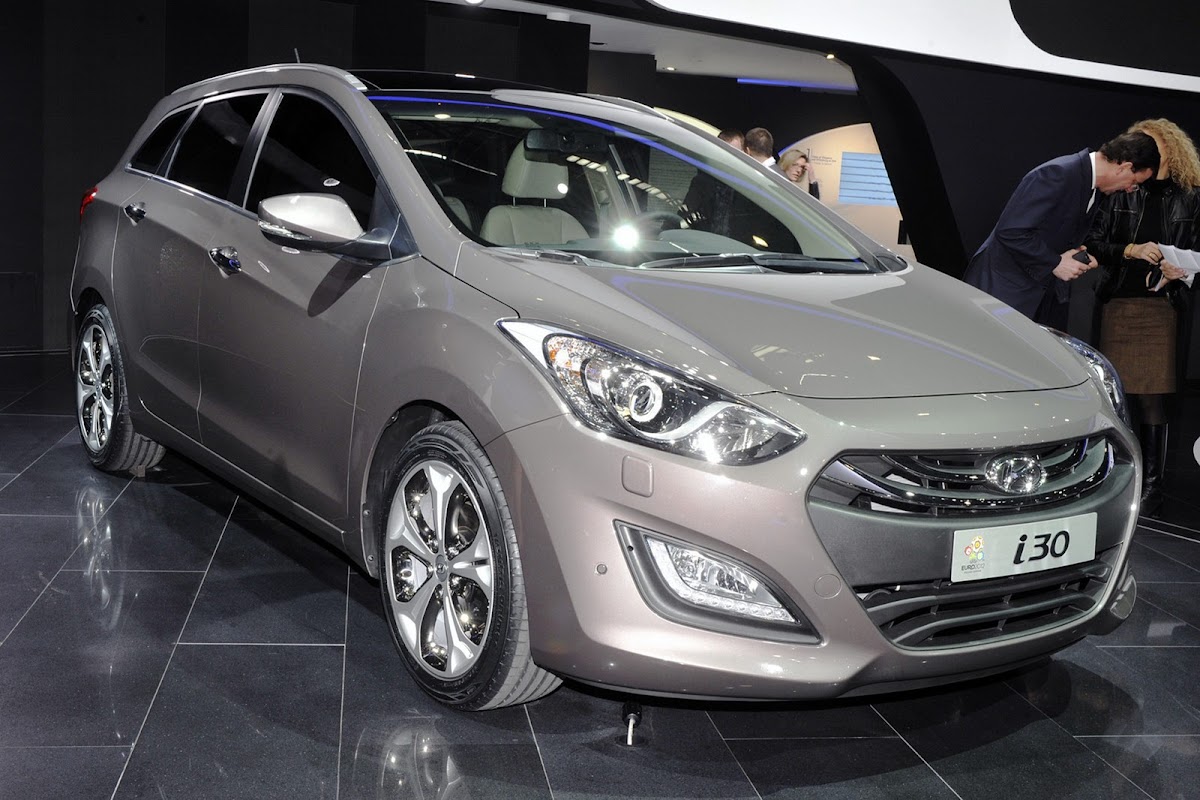
New 2013 Hyundai i30 Crossover wagon To Unveil at 2012 Geneva Motor Show on 6th march.
The wagon is based on the five-door i30 but measures 30mm longer. The extra room enables the model to have a cargo capacity of 528 liters (18.6 cubic feet) which can be expanded to 1642 liters (58 cubic feet) when the rear seats are folded down.
Hyundai's hexagonal grille, gem-like headlights and restyled taillights take the i30 from ho-hum family-hauling econobox to something boarding on stylish – a challenge for a utilitarian people mover – and the additional cargo space is surely a welcome addition for families with more kit to carry.
As is so often the case in the global market, the car can be fitted with five different engines. But all have modest power outputs, ranging from 80 hp to 133.
The New Generation i30 wagon was designed and engineered specifically for European customers at Hyundai’s European R&D Centre in Rüsselsheim, Germany.

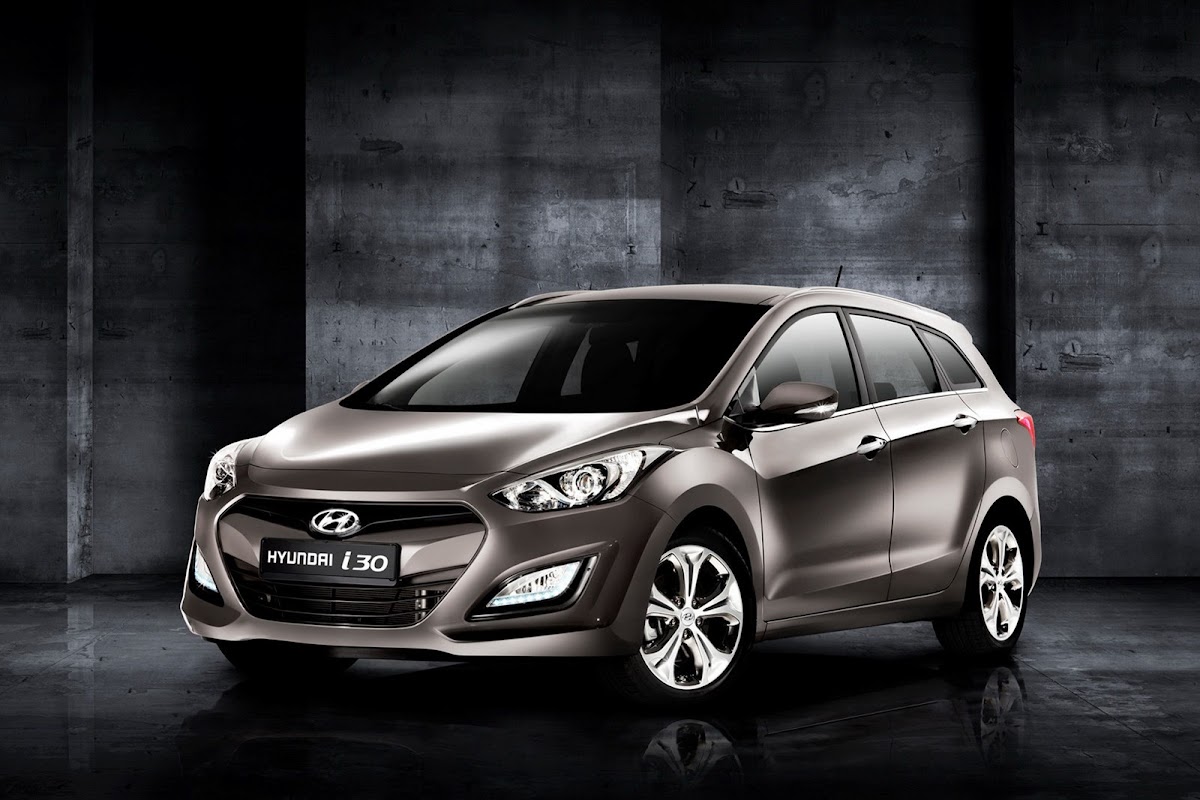
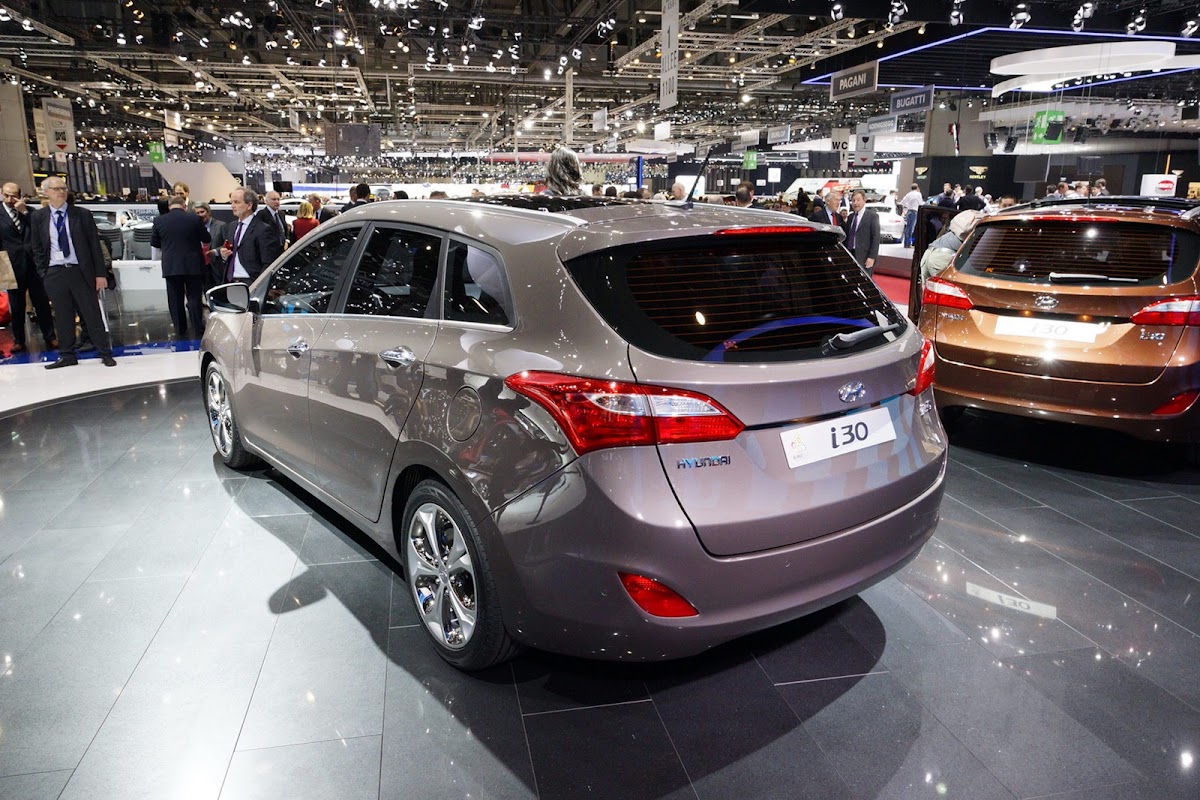




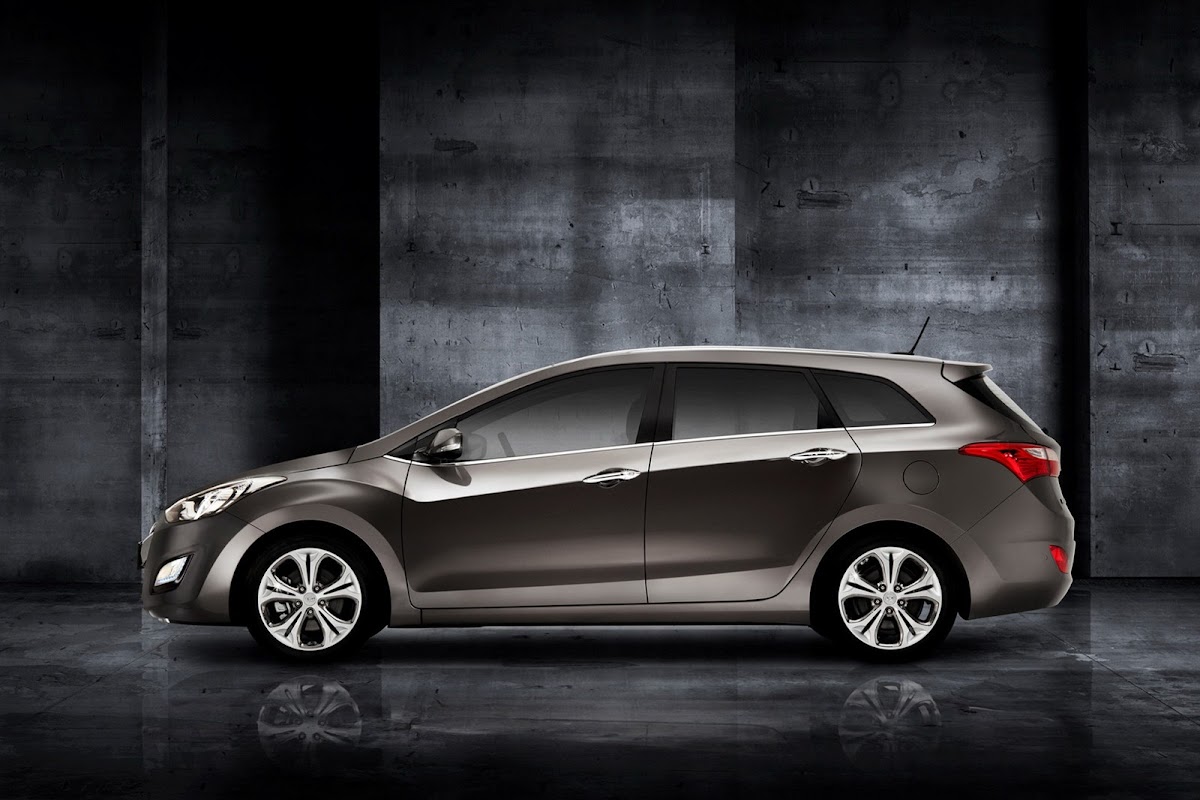
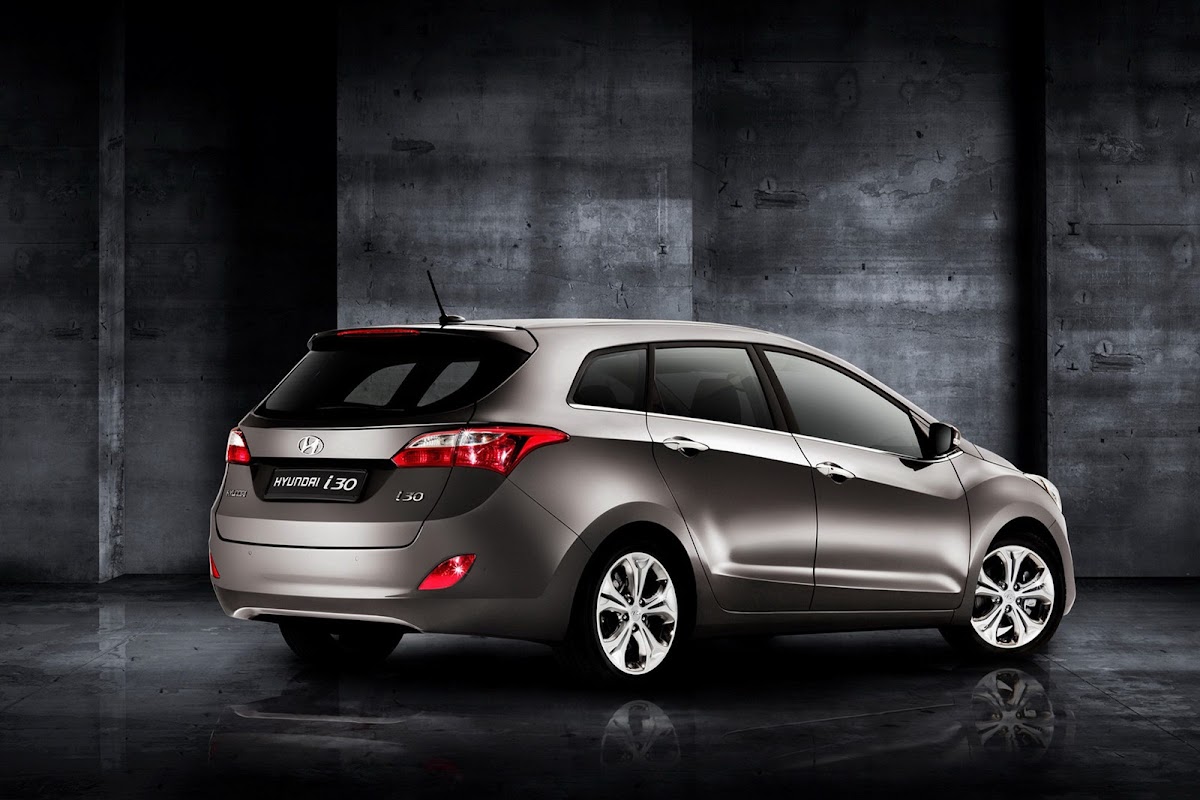

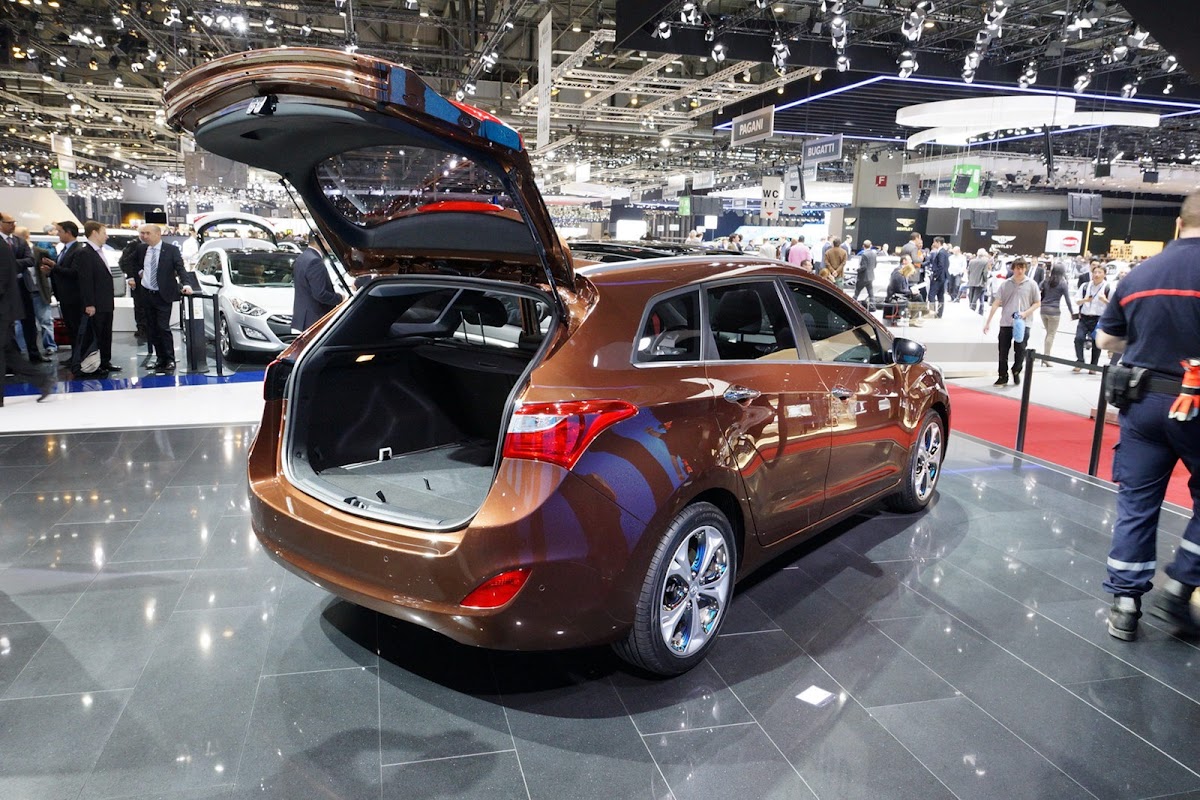

Press Release
Hyundai Motor Unveils New Generation i30 Wagon at the Geneva Motor Show
1. INTRODUCTION
New Generation i30 family extended at Geneva Motor Show
At the 2012 Geneva Motor Show, Hyundai has unveiled the wagon derivative of the New Generation i30 family, further broadening the model's appeal across Europe.
The New Generation i30 wagon will maintain Hyundai's reputation for producing visually-appealing, quality vehicles. The company expects the wagon bodystyle to significantly contribute to market share growth in Europe, with 30% of all New Generation i30 sales expected from the wagon derivative.
The stylish wagon shares engines and running gear with the New Generation i30 five-door, and has a longer body to create a useful increase in trunk space without compromising the model's dynamic styling.
Overall height of the wagon has increased by 30 mm compared to the New Generation i30 five-door, increasing the practical attributes of the car, while optional silver roof rails add further carrying capacity.
Adding to its practicality, the wagon's rear seats fold fully flat, boosting carrying capacity to 1.642-litres. With rear seats up, the New Generation i30 wagon features one of the largest cabin capacity of any C-segment model at 528-litres.
Similar to the five-door hatchback, the New Generation i30 wagon was designed and engineered at the Hyundai Motor Europe Technical Centre in Rüsselsheim, Germany. Developed under the company's global brand slogan, ‘New Thinking. New Possibilities.', the New Generation i30 family was developed specifically for the European market.
Allan Rushforth, Senior Vice President and COO of Hyundai Motor Europe, commented:"The New Generation i30 has been widely praised for its style, quality, and value. Our new wagon offers all of those attributes plus even greater load-carrying capacity. We expect it to appeal strongly to those looking for stylish and flexible practicality, especially active families."
The New Generation i30 family is produced in Europe at Hyundai's manufacturing facility in Nošovice, Czech Republic. The new model continues the Hyundai tradition of delivering vehicles of the highest quality to European motorists.
New Generation i30 wagon offers buyers the same class-leading powertrain line-up as the five-door derivative, with more powerful diesel (128 ps) and gasoline (135 ps) units, and six-speed transmissions for every model, plus CO2emissions starting at 109 g/km - making the i30 range one of the most efficient in the European C-segment.
Demonstrating its strong self-belief in the durability and quality of its products, Hyundai offers its customers in Europe the industry-best, fully-transparent Five Year Triple Care warranty. This award-winning package provides five years of unlimited-mileage warranty, five years of roadside assistance, and five years of vehicle health checks.
The New Generation i30 wagon will be available across Europe from July 2012.
Worth successor to best-seller
The original i30 range has defied the industry norm in terms of life-cycle sales fluctuations by recording increased annual sales over its first three years in the marketplace. Since launch in 2007, the i30 has recorded over 400.000 European sales, including more than 115.000 units in 2010 - the highest-ever annual sales figure for an individual Hyundai model on sale in Europe - and nearly 100.000 units during 2011 as the overall market declined dramatically.
So great was the success achieved by the original i30 that it climbed to number six in the C-segment sales rankings - securing a 4,8% share of the sector.
Hyundai expects the New Generation i30 family - enhanced by the wagon bodystyle - to restore its growth trend, contributing to future sales success, growing brand awareness and enhancing perceptions of Hyundai among European consumers.
The fortunes of the New Generation i30 family will also be helped by the anticipated market recovery. Motor industry analysts forecast that, despite numerous economic
uncertainties, the mainstream C-segment in Europe will grow by 7% over the next two years - reaching sales of 2,4 million vehicles per year by 2014. Hyundai is planning to sell more than 120.000 units of the New Generation i30 annually, helping to raise the brand's total sales to 500.000 units and challenging established competitors.
2. STYLING & DESIGN
Style inspired by nature
The wagon was developed alongside its five-door counterpart from the earliest stages, enabling designers to fashion a coherent form that bears a strong family resemblance inspired by Hyundai's fluidic sculpture form language.
Since its introduction on the Hyundai ix-onic concept at the 2009 Geneva Motor Show, fluidic sculpture has been the form language for all new Hyundai models launched in Europe.
As with the five-door variant, the front is distinguished by Hyundai's hexagonal-shaped grille and jewel-like headlamps, but from the B-pillar backwards the wagon differs significantly.
The roofline extends rearwards over the flexible passenger / cargo area, sloping to add dynamism to the car's stance in keeping with the fluidic sculpture ethos of a stationary car appearing to be in constant motion.
The overall height of the New Generation i30 wagon has been reduced by 20 mm compared to the original i30 wagon, ensuring an athletic profile. The length has increased by 10 mm compared to the original model.
Further enhancing the wagon's dynamic appearance, a pronounced swage line runs horizontally along the sides of the body and rises all the way to the rear lights. The rear windscreen wraps around the C-pillars, increasing interior luminosity and benefiting visibility. The deep tailgate gives the car a clean look and opens to bumper-level for easy loading.
Similar to the hatchback bodystyle, the New Generation i30 wagon benefits from an increased track. The bodyshell is 5 mm wider, and the front and rear tracks have also been increased, moving the wheels and tyres outwards to become flush with the wheel arches - simultaneously heightening the car's aesthetics and improving its road holding.
The profile of New Generation i30 wagon is given added finesse by the satin chrome beltline moulding beneath the glass house and by the new five-spoke 17-inch alloy wheels featuring chrome inserts.
The visual impact of New Generation i30 wagon on the road is also raised by the inclusion of standard LED daytime running lights flanking the grille and HID headlamps. The new model also bears Hyundai's signature frontal feature - the hexagonal-shaped grille, with a choice of single or twin chrome horizontal trim bars.
New Generation i30 wagon will be manufactured in Europe in a range of 11 exterior colours - two solid, seven metallic and two pearl. Seven popular colours from the previous model are carried over (Steel Gray, Blue Berry, Sleek Silver and Ice Blue metallics, Phantom Black and Cashmere Brown pearls and Creamy White solid).
Four new colours (Aqua Blue, Satin Amber and Hazel Brown metallics, plus solid Cool Red) will ensure an even fresher appearance for Hyundai's latest C-segment challenger. Inside, the New Generation i30 wagon seat and cabin trim is available in a choice of three colours - Black, Beige and Blue - in cloth; cloth and leather; or full leather variations.
3. FLEET
Driving fleet growth to a 50% share
Since going on sale in 2007, the original i30 has played an important role in expanding Hyundai's sales and reputation in Europe's fleet sector. Hyundai expects the New Generation i30 to be even more popular with fleet managers and company car drivers than its predecessor.
From the sales target of 120.000 units per year, Hyundai forecasts a split 50/50% between the fleet and private sectors.
Hyundai's Five Year Triple Care will continue to be a valuable point of differentiation for New Generation i30 wagon in a highly competitive class. The five-year warranty has no mileage limit, roadside assistance is included for five years, and vehicle health checks are performed annually, providing peace of mind for fleet buyers, fleet operators, company car drivers and private motorists.
Compared to the original i30, total cost of ownership for the New Generation i30 wagon model will be reduced, helped by improved fuel efficiency, lower CO2emissions and a lower insurance classification.
4. COMFORT & CONVENIENCE
Generous high-quality equipment ‘from the class above'
The quality and generosity of standard specification on the New Generation i30 wagon have been inspired by the high standards established by Hyundai's All New i40, demonstrating the company's desire to make its technology available to all European motorists.
Available new features that will appeal to New Generation i30 drivers include a Smart Key with engine start/stop button, 10-way powered driver's seat adjustment, heated front seats, an electric parking brake and cruise control with speed limiter function. Enhanced instrumentation with a TFT LCD Supervision cluster (executed to the same high quality as found on i40) provides a wide range of additional information to the driver in high-resolution clarity.
Located atop the centre stack, the optional navigation system is displayed via a 7-inch touch-screen. The system is a highly sophisticated and convenient GPS tool, offering real-time information, multi-media support and speech recognition in 10 European languages.
New features that will enhance the New Generation i30 wagon experience for passengers include dual-zone climate control, rear air ventilation ducts for second row occupants, and a panoramic glass sunroof which allows greatly increased natural light to flood the cabin. The sunroof has been designed to open fully or tilt open, offering flexibility and functionality, together with an adjustable full-length shade. Heat-reflecting solar glass is also available as an option for the front, side and rear windows.
Depending on model, New Generation i30 wagon's standard equipment also offers buyers a height-adjustable driver's seat, fully-folding rear seat, RDS radio/CD with MP3, iPod, Aux and USB support, six speaker audio system and a multi-mode trip computer.
Please note: Some markets may select particular powertrains and levels of equipment to suit the preferences of their local consumers - perhaps offering some ‘options' as standard on New Generation i30 wagon in their country. Please check the final technical specification and model-by-model equipment details with your national Hyundai PR staff.
5. ENGINES
Choice of six engines to power New Generation i30 wagon
Depending on individual market preferences, the New Generation i30 wagon will be available with an expanded choice of six engines - up to three diesel and three gasoline units - with a broader range of power outputs, from 90 to 135 ps.
New, more powerful engines are introduced to top both the diesel and gasoline line-ups delivering 128 ps and 135 ps respectively.
The upgraded diesel engine - the highly-efficient 1,6-litre variable geometry turbo (VGT) ‘U-II' unit - will be the most popular powertrain in the line-up. Generating 110 ps at 4.000 rpm and 260 Nm from 1.900 rpm, the upgraded 1582 cc engine will accelerate the New Generation i30 wagon from standstill to 100 kph in 11,8 seconds, and go on to reach a top speed of 185 kph - while emitting only 113 g/km of CO2.
The gasoline engines also offer an excellent balance between performance and economy. The New Generation 1,6-litre ‘Gamma' GDI engine features technically advanced ‘gasoline direct injection' to maximize power and torque generation while minimizing fuel consumption and emissions. This 1.591 cc unit produces 135 ps at 6.300 rpm and 164 Nm of torque at 4.850 rpm. With this engine, i30 accelerates to 100 kph in 10,2 seconds and up to a top speed of 192 kph top speed.
Both diesel and gasoline engine types play a significant role in the European
C-segment, with diesel representing 56% and gasoline 40% of total sales. Overall, Hyundai is expecting a 50:50% split between sales of diesel- and gasoline-powered New Generation i30 wagon models.
The addition of Hyundai technologies developed under the company's Blue DriveTM sub-brand optimizes efficiency and lowers emissions for the New Generation i30 wagon. These technologies, which are available on both diesel and gasoline models with manual transmission, include Integrated Stop & Go (ISG), low-rolling resistance tyres and an alternator management system (AMS).
Six-speed transmissions for every model
Buyers of New Generation i30 wagon will be given a choice between manual and automatic six-speed transmissions, depending on model, with both units providing a refined driving experience and enhanced fuel efficiency. The automatic transmission will be an option on all 1,6-litre engines, while the 1,4-litre units will be available exclusively with a manual gearbox.
6. RUNNING GEAR
Enhanced handling and variable power steering
As part of its improved dynamics, New Generation i30 wagon offers Hyundai's C-segment car buyers the new option of its innovative FLEX STEER system. This introduces three operating modes - Comfort, Normal and Sport - and allows the driver to vary the level of steering support and feedback in order to best suit the current driving conditions.
The Comfort mode gives greater electrical support, offering a ‘lighter' steering wheel and minimal effort to reach full steering lock. The improved maneuverability makes city driving and pulling in and out of a parking space easier than ever.
Normal mode is intended to be used most frequently. Offering the perfect support across all road types, its flexibility offers a relaxed, yet engaging drive.
Finally, Sport mode offers drivers the most direct feedback from the road with reduced electrical support. The steering feels more weighted, offering the most driver-focused experience. The direct control and feedback of Sport mode benefits use on highway routes.
The steering system employs electric power-assistance and requires 2,85 turns lock-to-lock for a 10,6-metre turning circle.
Fully-independent, all round, New Generation i30 wagon's suspension features subframe-mounted MacPherson struts at the front and a multi-link set up at the rear - both with optimized geometry to exploit the wider track of the new model for enhanced handling and improved road holding.
7. REFINEMENT
More cabin space and reduced interior noise
Occupants of New Generation i30 wagon benefit from more spacious interior dimensions compared to the five-door variant, while greater trunk volume offers increased luggage capacity and practicality.
Front seat occupants enjoy headroom of 1.033 mm (+12 mm compared to five-door), legroom of 1.067 mm and 1.420 mm shoulder room. Rear passengers enjoy significantly increased headroom (+38 mm to 1.005 mm) compared to the hatchback and improved access to and across the rear seats by lowering the floor's central tunnel by 59% (from 133 mm to just 54 mm).
Trunk capacity in the wagon bodystyle is increased to 528 litres with rear seats up, an increase of 113 litres compared to the original i30 (27%) and one of the segment-best figures. The trunk extends to 1.642 litres when the seats are folded fully flat (18% increase). New Generation i30 wagon owners can also utilise an underfloor storage compartment, boosting the carrying capacity.
Wheelbase remains the same as the hatchback model, at 2.650 mm.
The dashboard glovebox is enlarged by 48% to 8,0 litres (up from 5,4), bottle storage in the front door trims is doubled in size to 1,5-litres and new 0,75-litre storage pockets are provide in the rear doors, similar to its hatchback sibling.
In terms of cabin refinement and NVH, Hyundai's New Generation i30 wagon engineering team targeted the segment leaders, and was determined to achieve significant improvements over the original model.
Measures adopted to improve NVH included vibration damping engine mounts, fitting hollow drive shafts, stronger bodyshell joints between the sills and B-pillars, double-layer door seals, increased foam-filling in the A-pillars and re-shaped exterior door handles.
8. SAFETY
5-star safety features
Safety is a top priority for Hyundai and the New Generation i30 wagon features the latest active and passive safety technologies to ensure maximum protection for its occupants and other road users. Active safety features include ESC (Electronic Stability Control), VSM (Vehicle Stability Management), ABS (anti-lock braking system), BAS (emergency Brake Assist System), HAC (Hill Assist Control) to prevent roll-back and ESS (Emergency Stop Signal) which flashes the brake lights when an emergency stop is detected.
Good visibility is a key factor in safe driving and New Generation i30 wagon features LED daytime running lights to ensure it is seen - plus HID (High-Intensity Discharge) headlamps with AFLS (Adaptive Front Light System) to optimise the driver's night vision. To maximise safety when reversing, a wide angle rear view camera is available, showing a clear view of obstructions behind the car.
Personal security is also enhanced with New Generation i30 wagon by the ‘welcome lighting' package which features puddle lamps beneath the door mirrors and illuminated door handles - triggered by the proximity of the Smart Key as the owner approaches the parked car.
In terms of passive safety, the New Generation i30 wagon's bodyshell structure employs a high percentage of ultra high tensile steel and features three new cross-members which link to the front or rear suspension mounts for maximized rigidity. The front door anti-intrusion beams have been strengthened, the joint between the B-pillar and roof is enlarged and the inner and outer side sill panels are manufactured in high tensile steel.
Over 400 metallurgists are employed at Hyundai's steel plant in Korea to develop optimised steel recipes for every part and panel in our vehicles. As a result, the New Generation i30 wagon body-in-white has higher quality, higher tensile strength and lower weight than ever before. Hyundai is the only car manufacturer in the world to have its own fully integrated steel mill.
Each New Generation i30 wagon is fitted with six airbags as standard - front, front side and full length curtain - while an innovative driver's knee airbag is optional.
The safety features available on the New Generation i30 wagon reinforce Hyundai's excellent record on safety, and the company anticipates the new car will follow the outgoing model and five other recent Hyundai models, in attaining the maximum 5-Star rating in Euro NCAP's impact assessment programme.
9. TECHNICAL SPECIFICATIONS / EUROPE
New Generation i30 wagon
Body & Chassis
Five-door, five-seater wagon. Choice of up to six transversely mounted diesel and gasoline engines driving the front wheels via a six-speed manual or automatic transmission - depending on model and market.
Diesel engines
1,4-litre 90 ps
Type / capacity U-II 1,4, WGT, four-cylinder, DOHC 16-valve / 1396 cc
Power / torque 90 ps (66,0 kW) @ 4000 rpm / 220 Nm @1500-2750 rpm
Bore x Stroke (mm) 75,0 x 79,0
Compression ratio 17,0
1,6-litre 110 ps
Type / capacity U-II 1,6, VGT, four-cylinder, DOHC 16-valve / 1582 cc
Power / torque 110 ps (81,0 kW) @ 4000 rpm / 260 Nm @ 1900-2750 rpm
Bore x Stroke (mm) 77,2 x 84,5
Compression ratio 17,3
New 1,6-litre 128 ps
Type / capacity U-II 1,6, VGT, four-cylinder, DOHC 16-valve / 1582 cc
Power / torque 128 ps (94,0 kW) @ 4000 rpm / 260 Nm @ 1900-2750 rpm
Bore x Stroke (mm) 77,2 x 84,5
Compression ratio 17,3
Gasoline engines
1,4-litre 100 ps
Type / capacity Gamma 1,4 MPI, four-cylinder, DOHC 16-valve / 1396 cc
Power / torque 100 ps (73,2 kW) @ 5500 rpm / 137 Nm @ 4200 rpm
Bore x Stroke (mm) 77,0 x 74,99
Compression ratio 10,5
1,6-litre 120 ps
Type / capacity Gamma 1,6 MPI, four-cylinder, DOHC 16-valve / 1591 cc
Power / torque 120 ps (88,0 kW) @ 6300 rpm / 156 Nm @ 4850 rpm
Bore x Stroke (mm) 77,0 x 85,44
Compression ratio 10,5
1,6-litre 135 ps
Type / capacity Gamma 1,6 GDI, four-cylinder, DOHC 16-valve / 1591 cc
Power / torque 135 ps (99,0 kW) @ 6300 rpm / 164 Nm @ 4850 rpm
Bore x Stroke (mm) 77,0 x 85,44
Compression ratio 11,0
Transmissions
Diesel Gasoline
1,4 (90) 1,6 (110 / 128) 1,4 (100) 1,6 (120 / 135)
Manual 6-sp 6-sp / 6-sp 6-sp 6-sp / 6-sp
Automatic ----- 6-sp / 6-sp ----- 6-sp / 6-sp
Gear Ratios (Manual)
Diesel Gasoline
1,4 (90) 1,6 (110 / 128) 1,4 (100) 1,6 (120 / 135)
1st 3,769 3,636 / 3,636 3,769 3,615 / 3,615
2nd 2,040 1,962 / 1,962 2,045 1,955 / 1,955
3rd 1,189 1,189 / 1,189 1,370 1,370 / 1,370
4th 0,844 0,844 / 0,844 1,036 1,036 / 1,036
5th 0,702 0,702 / 0,702 0,893 0,893 / 0,893
6th 0,596 0,596 / 0,596 0,774 0,774 / 0,774
Reverse 3,583 3,583 / 3,583 3,700 3,700 / 3,700
Final Drive 4,188 3,941 / 3,941 4,400 4,267 / 4,267
Suspension and damping
Front Fully independent subframe-mounted MacPherson struts, with coil springs and gas-filled shock absorbers. Anti-roll stabiliser bar.
Rear Fully independent subframe-mounted multi-links, coil springs and gas-filled shock absorbers.
Steering
Type Motor-driven electric power steering, with (optional) FLEX STEER
Brakes
Front 15/16 inch (280/300 mm) ventilated disc with ABS and ESP
Rear 14 inch (262mm), EPB (284mm) solid discs with ABS and ESP
Booster size 10-inch
Wheels and tyres
Standard 6.0J x 15 inch steel 195 / 65 R15
(depending 6.0J x 15 inch alloy 195 / 65 R15
on model) 6.5J x 16 inch alloy 205 / 55 R16
7.0J x 17.0 inch alloy 225 / 45 R17
Spare Temporary mobility kit; Temporary spare tyre; Full-size spare tyre
Dimensions (mm)
Exterior
Overall length 4485 Overall width 1780 (excluding door mirrors)
Wheelbase 2650 Overall height 1500 (including roof rails)
Front track 1549 - 1569 depending on wheel/tyre combination
Rear track 1557 - 1571 depending on wheel/tyre combination
Front overhang 880 Rear overhang 955
Ground clearance 140
Interior Front Rear
Head room 1033 1005
Leg room 1067 880
Shoulder room 1420 1395
Hip room 1375 1296
Capacities (litres)
Fuel tank 53
Luggage 528 rear seats upright
1642 rear seats folded
Weights
Diesel 1,4 (90 M) 1,6 (110 M / A) 1,6 (128 M / A)
Curb weight (kg) 1322 1326 / 1348 1326 / 1348
Vehicle weight (kg) 1910 1920 / 1940 1920 / 1940
Gasoline 1,4 (100 M) 1,6 (120 M / A) 1,6 (135 M / A)
Curb weight (kg) 1213 1215 / 1249 1223 / 1255
Vehicle weight (kg) 1820 1820 / 1850 1820 / 1850
Performance
Diesel 1,4 (90 M) 1,6 (110 M / A) 1,6 (128 M / A)
Top speed (kph) 170 185 / 180 193 / 185
0-to-100 kph (sec) 13,9 11,8 / 12,7 11,2 / 12,1
Gasoline 1,4 (100 M) 1,6 (120 M / A) 1,6 (135 M / A)
Top speed (kph) 180 190 / 190 192 / 190
0-to-100 kph (sec) 13,5 11,2 / 12,3 10,2 / 11,3
Emissions
Diesel 1,4 (90 M) 1,6 (110 M / A) 1,6 (128 M / A)
CO2 (g/km) 113 113 / 149 113 / 149
Gasoline 1,4 (100 M) 1,6 (120 M / A) 1,6 (135 M / A)
CO2 (g/km) 145 152 / 165 140 / 163
Emissions (models with ISG)
Diesel 1,4 (90 M) 1,6 (110 M / A) 1,6 (128 M / A)
CO2 (g/km) 109 110 / --- 110 / ---
Gasoline 1,4 (100 M) 1,6 (120 M / A) 1,6 (135 M / A)
CO2 (g/km) 136 144 / --- 131 / ---
VIA «Car Trends»